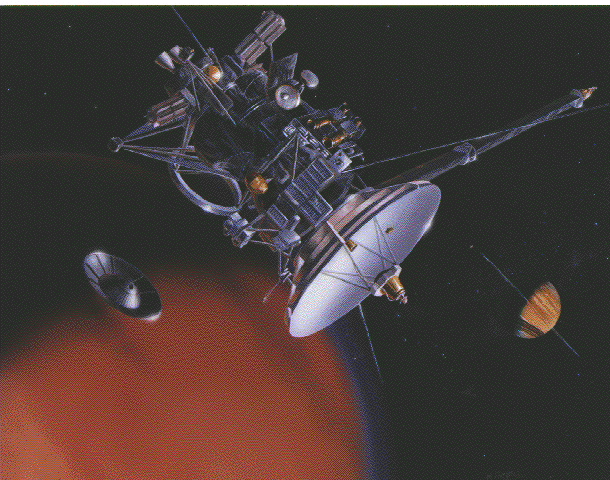






Selected Articles from the
August 1998 Odyssey
Editor: Norm Cook
- A New Lord of the Rings
- NASA Establishes New Office at JPL
- New Galileo Pictures of Ganymede Available
A New Lord of the Rings
By Robert Gounley
JPL's Dr. Ellis Miner, Chief Scientist for the Cassini mission to Saturn, recently gave an excellent overview of the program's history and objectives as the first speaker in CSDC's lecture series.
Cassini, a joint mission with NASA and the European Space Agency, is the latest of the planetary "flagship" missions. As the only Saturn explorer in a generation, it carries a full complement of scientific instruments to study the planet, its satellites, and the vast magnetosphere enclosing both. Upon entering permanent orbit about Saturn in July 2004, Cassini will become a permanent scientific station to explore everything about the ringed planet.
 |
| Artist's rendering of Cassini spacecraft at Saturn. NASA/JPL |
Thought once to be relatively featureless, Saturn's giant rings proved to be thousands of individual "ringlets." Somehow, Newton's Laws allow the gravity of eight major moons to tug at the billions of ring particles, yet still leave bands as distinct as the contrails of jets flying formation. With cameras more delicate than a jeweler's loupe, Cassini may unravel this mysterious clockwork.
Saturn's icy moons occasionally display dramatic features. Mimas, lightly pock-marked over most of its surface, carries a gaping crater nearly a quarter of its total diameter. Enceledas, an apparently placid world, may harbor ice volcanoes that replenish particles for a major ring. Iapetus balances its yin with its yang by keeping one face as bright as snow and another as dark as coal. Cassini will explore them all.
Titan, the largest of Saturn's moons, supports a dense atmosphere, rich in methane and ammonia. On 27 November, 2004, ESA's probe, Huygens, enters it to explore whatever is hidden beneath. Descending gently by large parachutes, the probe will sniff the air around it to sample weather data and local chemistry. Nearer the ground, cameras onboard image a surface of ... what? Water ice snow? Rocks? An ocean of liquid ethane? Huygens can land on any of them.
Saturn was last visited by the twin Voyager spacecraft back in the early 1980s. In 2004, through the Cassini spacecraft, Mankind will return--this time to stay.
NASA Establishes Near-Earth Object
Program Office at JPL
A new program office to coordinate NASA-sponsored efforts to detect, track, and characterize potentially hazardous asteroids and comets that could approach Earth will be established at NASA's Jet Propulsion Laboratory (JPL) in Pasadena.
NASA's Near-Earth Object Program Office will focus on the goal of locating at least 90 percent of the estimated 2,000 asteroids and comets that approach the Earth and are larger than about 2/3-mile (about 1 kilometer) in diameter, by the end of the next decade.
"These are objects that are difficult to detect because of their relatively small size, but are large enough to cause global effects if one hit the Earth," said Dr. Donald K. Yeomans of JPL, who will head the new program office. "Finding a majority of this population will require the efforts of researchers at several NASA centers, at universities, and at observatories across the country, and will require the participation by the international astronomy community as well."
"We determined that, in order to achieve our goals, we need a more formal focusing of our near-Earth object tracking efforts and related communications with the supporting research community," said Dr. B. Carl Pilcher, science director for Solar System Exploration in NASA's Office of Space Science, NASA Headquarters. "I want to emphasize that science research solicitations and resulting peer reviews, international coordination, and strategic planning regarding future missions will remain the responsibilities of NASA Headquarters."
In addition to managing the detection and cataloging of near-Earth objects, the new NASA office will be responsible for facilitating communications between the astronomical community and the public should any potentially hazardous objects be discovered as a result of the program, Pilcher said.
JPL was selected to host the program office because of its expertise in precisely tracking the positions and predicted paths of asteroids and comets. No significant additional staff hiring at JPL is expected at this time.
A fact sheet describing NASA's research and spacecraft missions related to asteroids and comets is available on the Internet at the following address: http://www.hq.nasa.gov/office/pao/facts/HTML/FS-023-HQ.htm.
New Galileo Pictures of Ganymede Available
New high-resolution images taken by NASA's Galileo spacecraft of Jupiter's largest moon, Ganymede, are on the Internet at: http://www.jpl.nasa.gov/galileo/sepo/atjup/newim.html and at http://photojournal.jpl.nasa.gov.
The images were taken by Galileo's camera during several Ganymede flybys between June 1996 and June 1997. They reveal impact craters with unusual pedestals, dark ejecta haloes, evidence of tectonic activity, and possible signs of icy volcanic flows. A crater chain seems to be the result of impacts from a broken-up comet, like the 1994 Shoemaker-Levy impact on Jupiter.
Ganymede is the largest moon of any planet in the solar system. Its distinctive surface is composed half of bright water ice, and half of older, dark, heavily cratered terrain containing ice and rocks. The new images show surface details including abundant remnants of old craters and basins in the dark terrain, thought to date from early in the solar system's history. The images also reveal a complex transition from dark, old terrain to bright, new terrain, where parallel rows of linear mountain-like ridges extend for hundreds of kilometers (or miles). During the early part of Ganymede's history, it is very likely that a global ocean existed below the surface, just as an ocean may exist on Europa today. A complex valley with a lobe-shaped flow appears to be a source of liquid water volcanism. Younger faults are seen cross-cutting older features, which helps scientists piece together the sequence of events in Ganymede's history.
Copyright © 1998-2003 Organization for the Advancement of Space Industrialization and Settlement. All Rights Reserved.